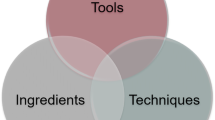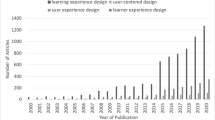Abstract
THIS PAPER examines the concept of learning objects, the advantages they offer, and related issues. Learning objects focus on content, while the Learning Design specification addresses pedagogy. Underlying both of these approaches is the motivation to reuse, which has cost and quality benefits. Despite these benefits, adoption of the two approaches has not impacted on everyday practice. The process of technology succession is suggested as a method by which these two approaches may increase their adoption.
Similar content being viewed by others
References
Berge, Z. (1997). Computer conferencing and the on-line classroom.International Journal of Educational Telecommunications, 3(1), 3–21.
Britain, S. (2004, May).A Review of learning design: Concept, specifications and tools. Joint Information Systems Committee (JISC). Retrieved September 29, 2006, from http://www.jisc.ac.uk/uploaded_documents/ACF83C.doc.
Carson, S. (2005).MIT CCW evaluation findings. Retrieve September 29, 2006, from http://ocw.mit.edu/NR/rdonlyres/90C9BC91-7819-48A0-9E9A-D6B2701C1CE5/0 /MIT_OCW_2004_Program_Eval.pdf.
Downes, S. (2001). Learning objects: Resources for distance education worldwide.International Review of Research in Open and Distance Learning, 2(1). Retrieved September 5, 2006, from http://www.irrodl.org/index.php/irrodl/article/view/32/378
Downes, S. (2003).Design, standards and reusability. Retrieved September 29, 2006, from http://www.downes.ca/cgi-bin/website/view.cgi?dbs=Article&key=1059622263.
Duncan, C. (2003). Granularisation. In A. Littlejohn (Ed.),Reusing online resources: A sustainable approach to elearning (pp. 12–19). London: Kogan Page.
Friesen, N. (2001). What are educational objects?Interactive Learning Environments, 9(3), 219–230. Retrieved September 5, 2006, from http://www.careo.org/documents/objects.html
Hummel, H.G.K., Manderveld, J.M., Tattersall, C. & Koper, E.J.R. (2004). Educational modelling language and learning design: New opportunities for instructional reusability and personalised learningInternational Journal of Learning Technology, 1(1), 111–126.
IMS (2003a).IMS learning design best practice and implementation guide. Retrieved September 29, 2006, from http://www.imsglobal.org/learningdesign/ldv1p0/ imsld_bestv1p0.html.
IMS (2003b).IMS learning design information model. IMS Global. Retrieved September 29, 2006, from http://www.imsproject.org/learningdesign/ldv1p0/ imsld_infov1p0.html.
Neven, F., & Duval, E. (2002, December 1–6). Reusable learning objects: A survey of LOM-based repositories.Proceedings of the ACM Multimedia 2002 (pp. 107–114). Juan Les Pins, France. Retrieved September 5, 2006, from www.cs.kuleuven.ac.be/≈hmdb/publications/files/pdfversion/41249.pdf.
OECD (2005). E-learning in tertiary education: Where do we stand?Education & Skill, (4), 1–11.
Rehak, D.R., & Mason, R.D. (2003). Keeping the learning in learning objects. In A. Littlejohn (Ed.),Reusing Educational Resources for Networked Learning (pp. 20–34). London: Kogan Page.
South, J.B., & Monson, D.W. (2000). A university-wide system for creating, capturing, and delivering learning objects. In D.A. Wiley (Ed.),The Instructional Use of Learning objects: Online Version. Retrieved September 29, 2006, from http:// reusability.org/read/chapters/south.doc.
Strijker, A. (2004).Reuse of learning objects in context. Human and technical aspects. PhD Dissertation. Faculty of Behavioural Sciences, University of Twente, Enschede, Netherlands. Retrieved September 4, 2006, from http://www.actapress.com/ Reference.aspx?paperld=20499.
Weller, M.J., Pegler, C.A., & Mason, R.D. (2003). Putting the pieces together: What working with learning objects means for the educator.Elearn International. Edinburgh. Retrieved September 5, 2006, from iet.open.ac.uk/pp/c.a.pegler/ukeu/edinburgh.doc.
Weller, M.J. (2004). Learning objects and e-learning cost dilemma.Open Learning, 19(3), 293–302.
Wilhelm, P., & Wilde, R. (2005). Learning objects in a box: Developing a university course for on-line delivery based on learning objects: From ideals to compromises.Open Learning, 20(1) 65–81.
Wilson, W., Olivier, B., Jeyes, S., Powell, A., & Franklin, T. (2004).A technical framework to support e-learning. JISC. Weller, M.J. (2003). Retrieved September 23, 2006, from http:/ /www.jisc.ac.uk/uploaded_documents/Technical%20Framework%20feb04.doc
Author information
Authors and Affiliations
Additional information
ABOUT THE AUTHOR Martin Weller is Professor of Educational Technology at the Open University in the U.K. He was Director for the VLE project at the Open University and has chaired several e-learning courses. His research interests include learning environments, new technologies, learning design, and the implications of e-learning for higher education. Dr. Weller has published numerous articles in these areas and is the author of the textbookDelivering Learning on the Net. His new book on VLEs is scheduled for publication in 2007. Dr. Weller is currently the Project Director for the D4LD project that is developing a Learning Design player.
Rights and permissions
About this article
Cite this article
Weller, M. Learning objects, learning design, and adoption through succession. J. Comput. High. Educ. 19, 26–47 (2007). https://doi.org/10.1007/BF03033418
Issue Date:
DOI: https://doi.org/10.1007/BF03033418




